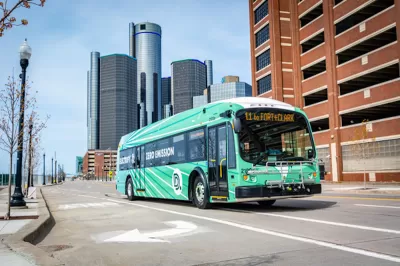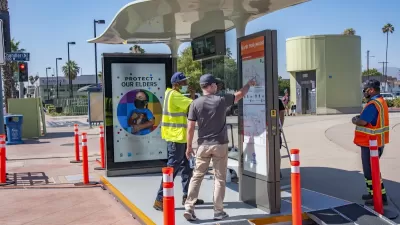The city’s thousands of bus stops are sorely lacking in seating and shelters to protect riders from rain, snow, and sun.

An analysis of city data reveals that just 5 percent of bus stops in Detroit have shelters, and only 1.5 percent have benches, reports Malachi Barrett for Bridge Detroit.
The data reveals a stunning lack of infrastructure in a city with frigid winters, which coincide with a drop in bus usage. “DDOT data shows 400,000 fewer riders in December 2024 compared to October,” Barrett notes. According to Ted Tansley, who compiled the data, “It’s a clear reflection of the lack of institutional funding.”
DDOT acknowledged that a low percentage of its bus stops have seating or shelters. However, in a statement to BridgeDetroit, the department argued focusing it’s misleading to focus on the raw percentage of stops without a shelter because 26% of bus boardings happen at a sheltered stop. In other words, the stops with higher ridership are more likely to have shelters or seating.
Transit advocates are calling on city leaders to boost funding for the Department of Transportation, which served over 250,000 bus riders each week. The department says it plans to add 250 shelters by 2027 along high-traffic routes and near areas with high concentrations of seniors.
As part of its DDOT Reimagined plan, it has set a goal to have 75 percent of riders boarding from a sheltered bus stop and improve the transit experience in other ways, but the agency needs more funding to achieve its vision. “Additional investment could add more frequency to routes, upgrade stops with shelters and benches, raise wages for employees and ultimately improve service for residents who can’t afford or to drive or don’t wish to.”
FULL STORY: Detroit bus shelters are scarce as advocates call for more funding

Maui's Vacation Rental Debate Turns Ugly
Verbal attacks, misinformation campaigns and fistfights plague a high-stakes debate to convert thousands of vacation rentals into long-term housing.

Planetizen Federal Action Tracker
A weekly monitor of how Trump’s orders and actions are impacting planners and planning in America.

In Urban Planning, AI Prompting Could be the New Design Thinking
Creativity has long been key to great urban design. What if we see AI as our new creative partner?

King County Supportive Housing Program Offers Hope for Unhoused Residents
The county is taking a ‘Housing First’ approach that prioritizes getting people into housing, then offering wraparound supportive services.

Researchers Use AI to Get Clearer Picture of US Housing
Analysts are using artificial intelligence to supercharge their research by allowing them to comb through data faster. Though these AI tools can be error prone, they save time and housing researchers are optimistic about the future.

Making Shared Micromobility More Inclusive
Cities and shared mobility system operators can do more to include people with disabilities in planning and operations, per a new report.
Urban Design for Planners 1: Software Tools
This six-course series explores essential urban design concepts using open source software and equips planners with the tools they need to participate fully in the urban design process.
Planning for Universal Design
Learn the tools for implementing Universal Design in planning regulations.
planning NEXT
Appalachian Highlands Housing Partners
Mpact (founded as Rail~Volution)
City of Camden Redevelopment Agency
City of Astoria
City of Portland
City of Laramie





























